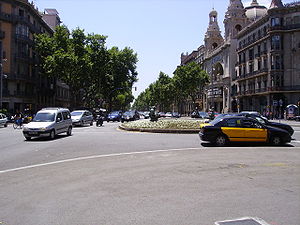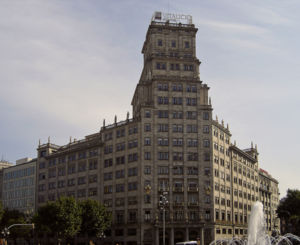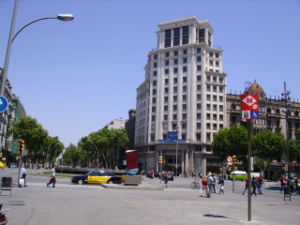
Gran Via de les Corts Catalanes, Barcelona
Encyclopedia



Barcelona
Barcelona is the second largest city in Spain after Madrid, and the capital of Catalonia, with a population of 1,621,537 within its administrative limits on a land area of...
's major avenues. With a length of 13.1 kilometres, it is the longest street in Spain
Spain
Spain , officially the Kingdom of Spain languages]] under the European Charter for Regional or Minority Languages. In each of these, Spain's official name is as follows:;;;;;;), is a country and member state of the European Union located in southwestern Europe on the Iberian Peninsula...
.
Location
It crosses the entire city proper, stretching from the North-Eastern boundaries of the municipality, bordering Sant Adrià de BesòsSant Adrià de Besòs
Sant Adrià de Besòs is a city in the comarca of the Barcelonès in Catalonia, northern Spain. It is situated at the mouth of the river Besòs, extending to both sides of the estuary. The original settlement with the parish church is on the left bank of the river, in the north of the municipal...
, to its South-Western limits, in L'Hospitalet de Llobregat
L'Hospitalet de Llobregat
L'Hospitalet de Llobregat or briefly L'Hospitalet is a city to the immediate southwest of Barcelona in Catalonia, Spain, and the second largest in Catalonia by population...
, with some of Barcelona's most important squares in between: Plaça d'Espanya
Plaça d'Espanya (Barcelona)
Plaça d'Espanya is one of Barcelona's most important squares, built on the occasion of the 1929 International Exhibition, held at the foot of Montjuïc, in the Sants-Montjuïc district.-Features:...
, Plaça Universitat, Plaça Catalunya, Plaça de Tetuan and Plaça de les Glòries Catalanes. It's over thirteen kilometres long.
History
The late 19th century urban plannerUrban planning
Urban planning incorporates areas such as economics, design, ecology, sociology, geography, law, political science, and statistics to guide and ensure the orderly development of settlements and communities....
Ildefons Cerdà
Ildefons Cerdà
Ildefons Cerdà i Sunyer was the progressive Catalan Spanish urban planner who designed the 19th-century "extension" of Barcelona called the Eixample.-Biography:...
included it as an essential part of his draft of the new "Projecte de reforma i eixample de Barcelona" (nowadays simply known as "Pla Cerdà"), as a wide road linking a number of villages around the coastal part of Barcelona, and called it Lletra N, Número 11. It was renamed Corts in 1900, as a reference to the Mediaeval Corts of Barcelona. Later on, after the Second Spanish Republic
Second Spanish Republic
The Second Spanish Republic was the government of Spain between April 14 1931, and its destruction by a military rebellion, led by General Francisco Franco....
was proclaimed in 1931, it was again renamed as Corts Catalanes. With the Francoist victory after the Civil War
Spanish Civil War
The Spanish Civil WarAlso known as The Crusade among Nationalists, the Fourth Carlist War among Carlists, and The Rebellion or Uprising among Republicans. was a major conflict fought in Spain from 17 July 1936 to 1 April 1939...
, its name was changed to Avenida de José Antonio Primo de Rivera
José Antonio Primo de Rivera
José Antonio Primo de Rivera y Sáenz de Heredia, 1st Duke of Primo de Rivera, 3rd Marquis of Estella , was a Spanish lawyer, nobleman, politician, and founder of the Falange Española...
in 1939. With the restoration of democracy, its name became Gran Via de les Corts Catalanes in 1979.
The construction of a Trambesòs
Trambesòs
The Trambesòs is a light rail system operated by TRAMMET connecting Sant Adrià de Besòs and Badalona with the city of Barcelona in Catalonia. The original line, known as T4, opened on May 8, 2004 and runs from Ciutadella-Vila Olímpica in Barcelona to the east of the city and extends roughly...
station is currently underway.
Metro
The first line in the Barcelona metro system, built in the 1920s under the name "Gran Metro", covered the distance between Plaça Catalunya and Plaça Espanya, which is nowadays part of Line 1.There are several metro
Barcelona Metro
The Barcelona Metro , part of the public transportation system of Barcelona, Catalonia, is an extensive network of electrified railways that run underground in central Barcelona and above ground into the city's suburbs. Since July 31, 2010, Barcelona Metro system consists of 11 lines with 165...
stations located on Gran Via nowadays.
- Ildefons Cerdà (L8)
- Magòria-La Campana (L8)
- Espanya (L1, L3, L8)
- Rocafort (L1)
- Urgell (L1)
- Universitat (L1, L2)
- Passeig de Gràcia (L1, L2, L4)
- Tetuan (L2)
- Glòries (L1)
- Besòs (L4)
Places of note
- Cinema Coliseum
- A 2001 monument to the victims of Fascist ItalianKingdom of Italy (1861–1946)The Kingdom of Italy was a state forged in 1861 by the unification of Italy under the influence of the Kingdom of Sardinia, which was its legal predecessor state...
aviation bombings during the Spanish Civil WarSpanish Civil WarThe Spanish Civil WarAlso known as The Crusade among Nationalists, the Fourth Carlist War among Carlists, and The Rebellion or Uprising among Republicans. was a major conflict fought in Spain from 17 July 1936 to 1 April 1939...
, opposite Cinema Coliseum. - Font de Diana, a noucentistaNoucentismeNoucentisme was a Catalan cultural movement of the early 20th century that originated largely as a reaction against Modernisme, both in art and ideology, and was, simultaneously, a perception of art almost opposite to that of avantgardists...
monument representing goddess DianaDiana (mythology)In Roman mythology, Diana was the goddess of the hunt and moon and birthing, being associated with wild animals and woodland, and having the power to talk to and control animals. She was equated with the Greek goddess Artemis, though she had an independent origin in Italy...
by Venanci Vallmitjana (1911–1929) - Plaça de les Glòries Catalanes
- Banco Vitalicio Building
- Homage to books, monument by Joan BrossaJoan BrossaJoan Brossa i Cuervo Joan Brossa i Cuervo Joan Brossa i Cuervo (Barcelona, Catalonia,(1919–1998) was a Catalan poet in the Catalan language, playwright, graphic designer and plastic artist. He was one of the founders of both the group and the publication known as Dau-al-Set (1948) and one of the...
in reference to the annual Book Fair in the Passeig de Gràcia with Gran Via de les Corts Catalanes. - The Plaza Monumental de Barcelona
- Plaça de la Universitat
- Plaça d'Espanya
- Plaça de Tetuan
- Ciutat de la Justícia de Barcelona i l'Hospitalet de LlobregatCiutat de la Justícia de Barcelona i l'Hospitalet de LlobregatCiutat de la Justícia de Barcelona i l'Hospitalet de Llobregat or just Ciutat de la Justícia is a recent architectural development in the Sants-Montjuïc district of Barcelona and its immediately adjacent suburb l'Hospitalet de Llobregat, on Gran Via de les Corts Catalanes 642 near Plaça d'Ildefons...
See also
- Ildefons CerdàIldefons CerdàIldefons Cerdà i Sunyer was the progressive Catalan Spanish urban planner who designed the 19th-century "extension" of Barcelona called the Eixample.-Biography:...
- EixampleEixampleThe Eixample is a district of Barcelona between the old city and what were once surrounding small towns , constructed in the 19th and early 20th centuries....
, List of streets and squares in Eixample - BarcelonaBarcelonaBarcelona is the second largest city in Spain after Madrid, and the capital of Catalonia, with a population of 1,621,537 within its administrative limits on a land area of...

